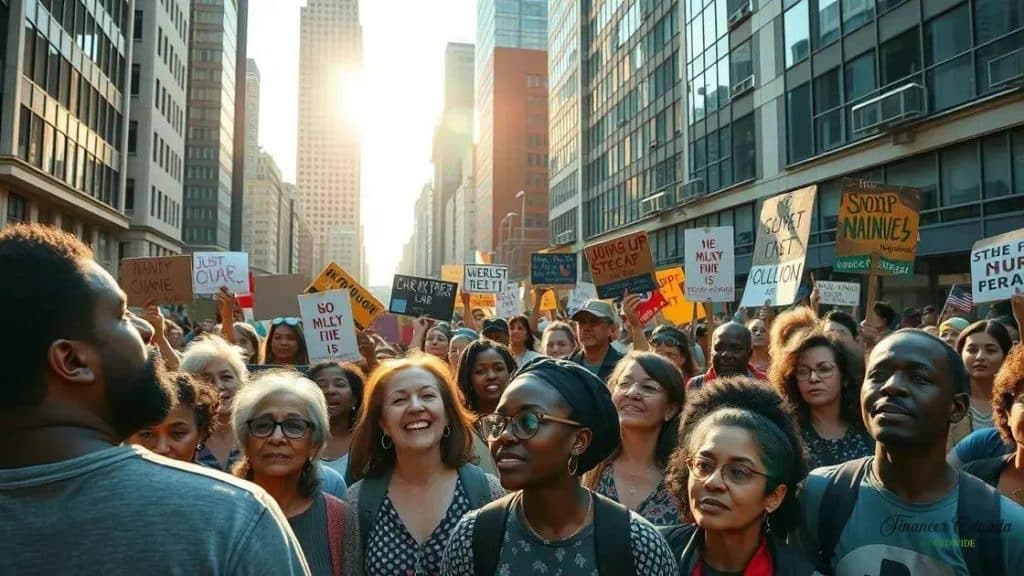Social movements and their impact on government policies

Social movements significantly impact government policies by mobilizing public opinion, advocating for change, and influencing legislators to address social injustices and community needs.
Social movements and their impact on government policies play a crucial role in shaping the decisions that affect our lives. Have you ever considered how grassroots actions can lead to significant changes? Let’s delve into the dynamics between these movements and the policies they influence.
Understanding social movements
Understanding social movements is essential to grasp how they can drive change in society. These movements often arise from the collective action of individuals who share common goals, such as advocating for rights or challenging injustices. Knowing their roots helps us appreciate their importance in shaping public discourse.
Characteristics of Social Movements
Social movements have unique characteristics that distinguish them from other forms of activism. They typically focus on change over time, engaging in various strategies to achieve their goals. Some notable features include:
- Collective action: Individuals join together to voice shared concerns.
- Goals: Defining aims, such as policy changes or raising awareness.
- Organizational structure: Many have leaders and organized groups to coordinate efforts.
Furthermore, social movements often depend on public engagement and media coverage to amplify their messages. The use of social media, for instance, has transformed how movements operate today, allowing for rapid mobilization and widespread outreach.
Types of Social Movements
There are various types of social movements, each with different objectives and methods. Recognizing these categories helps understand their impact more clearly. Common types include:
- Reform movements: Aim to change specific laws or policies.
- Revolutionary movements: Seek to alter the entire system.
- Resistance movements: Focus on preserving cultural values or structures.
These movements play a crucial role in addressing pressing issues and often pave the way for significant legislative changes. Historical examples demonstrate how organized efforts can lead to transformative changes in government policies.
Historical impact on legislation

The historical impact of social movements on legislation is profound and far-reaching. Over the years, these movements have led to significant changes in laws that address social, economic, and political issues. By raising awareness and mobilizing public support, they have influenced policymakers and shaped the legal landscape.
Key Legislative Changes
Several key legislative changes highlight the influence of social movements. These movements often bring attention to injustices, prompting action from lawmakers. For example:
- The Civil Rights Movement: This movement played a crucial role in the passage of the Civil Rights Act of 1964, which ended segregation in public places.
- The Women’s Suffrage Movement: Activism by women in the early 20th century led to the 19th Amendment, granting women the right to vote.
- The LGBTQ+ Rights Movement: Advocacy from this community has resulted in significant legal protections, such as marriage equality in many countries.
These examples show how dedicated efforts can lead to lasting change. Social movements often employ strategic tactics, such as protests and lobbying, to attract attention to their causes.
Strategies Used by Social Movements
Social movements utilize various strategies to influence legislation. Understanding these tactics is essential to see how they effectively push for change. Some common strategies include:
- Grassroots organizing: Mobilizing local communities to advocate for change.
- Public demonstrations: Organizing marches or rallies to raise awareness.
- Engaging with policymakers: Lobbying efforts aimed at legislators can secure vital support.
These strategies often enhance visibility and lend credibility to their causes. They help create momentum that can lead to legislative advancements, illustrating the crucial link between social activism and policy change.
Case studies of successful movements
Examining case studies of successful movements provides valuable insights into the dynamics that lead to impactful change. Each movement has its unique story, shaped by the goals, strategies, and the social context of its time. Understanding these examples can inspire current and future activists.
The Civil Rights Movement
The American Civil Rights Movement of the 1960s is one of the most notable examples of a successful social movement. Activists aimed to end racial segregation and discrimination against African Americans. They utilized peaceful protests, boycotts, and legal challenges to achieve their goals. Key events, such as the March on Washington, highlighted their demands and rallied broad support.
The Women’s Rights Movement
The Women’s Rights Movement has successfully achieved significant milestones over the years. One landmark event was the Seneca Falls Convention in 1848, where women first formally demanded equality. This movement successfully led to the passage of the 19th Amendment in 1920, granting women the right to vote, illustrating the power of persistent advocacy.
The LGBTQ+ Rights Movement
The LGBTQ+ Rights Movement has made remarkable progress in recent decades. One pivotal event was the Stonewall Riots in 1969, which energized the fight for LGBTQ+ rights. This movement has resulted in many legislative victories, including marriage equality in various countries, showcasing how collective action can lead to social policy changes.
- Effective strategies: These movements used public demonstrations to raise awareness.
- Legal challenges: Many focused on court cases to change unjust laws directly.
- Community engagement: Building inclusive coalitions strengthened their impact.
By analyzing these case studies, we see how diverse social movements mobilize communities, craft effective strategies, and leverage public opinion to influence government policies.
Current trends in activism

Current trends in activism reflect how society evolves and responds to challenges. Today, activists use a mix of traditional and digital strategies to raise awareness and promote change. These trends reveal the adaptability and creativity of movements across the globe.
Digital Activism
One of the most significant trends is the rise of digital activism. Social media platforms allow activists to organize, share information, and engage with a wider audience. Hashtags and online campaigns have the power to spread messages quickly. For instance, movements like #MeToo and Black Lives Matter gained international attention due to their strong online presence.
Intersectionality in Activism
Another important trend is the focus on intersectionality. Activists increasingly recognize that issues like race, gender, and class are interconnected. This approach ensures that campaigns address the needs of diverse groups. It encourages solidarity among various movements, leading to more inclusive outcomes.
- Collaboration: Activists team up across different social issues for greater impact.
- Grassroots movements: Local organizations are gaining more recognition and support.
- Environmental justice: Many movements are linking social issues to environmental concerns.
As the world faces new challenges, these trends show how flexibility and innovation shape activism today. From utilizing technology to fostering collaboration, activists are finding new ways to make their voices heard.
The relationship between publics and policies
The relationship between publics and policies is crucial for understanding how social movements affect government actions. Public opinion often plays a significant role in shaping policies. When a movement successfully rallies public support, it can lead to substantial changes in legislation and governance.
The Role of Public Opinion
Public opinion acts as a powerful force in the policy-making process. Lawmakers often pay close attention to the attitudes and beliefs of their constituents. When large segments of the population express their views, it can compel politicians to take action. This dynamic is evident when social movements use surveys and polling to demonstrate widespread support for their causes.
Influencing Policy Through Advocacy
Activists have many strategies to influence public policies. Effective advocacy often includes:
- Education: Raising awareness about issues through campaigns and discussions.
- Media Engagement: Utilizing news outlets and social media to spread their message widely.
- Lobbying: Engaging directly with lawmakers to push for specific policy changes.
By employing these tactics, activists can bring attention to issues that might otherwise be overlooked. They create a dialogue between the public and policymakers, facilitating a better understanding of community needs.
The feedback loop between the public and policymakers is vital. When the public mobilizes, it can lead to pressure on officials to respond to the demands of social movements. This interaction ultimately results in policies that reflect the community’s desires and challenges, illustrating how crucial the relationship between publics and policies truly is.
FAQ – Frequently Asked Questions About Social Movements and Their Impact on Government Policies
How do social movements influence public policies?
Social movements influence public policies by mobilizing public opinion and advocating for specific changes, often pressing lawmakers to take action.
What role does public opinion play in activism?
Public opinion is crucial in activism as it can sway policymakers by demonstrating a collective desire for change.
Why is digital activism important today?
Digital activism is important because it allows movements to reach larger audiences quickly and fosters engagement through social media.
What does intersectionality mean in the context of social movements?
Intersectionality acknowledges that various social identities, such as race and gender, intersect and must be considered to address diverse issues within movements.





